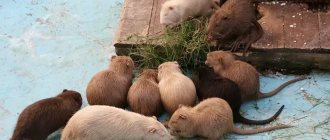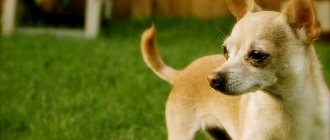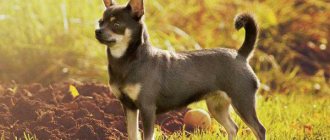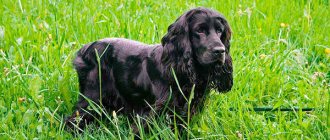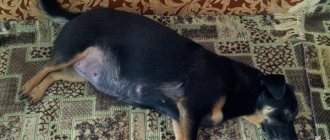Pugs can easily be called one of the kindest and most loyal dog breeds. They are friendly to all family members, love to play with children, are ready to rest when it is convenient for the owner, and caring for them is not particularly difficult.
It must be remembered that any breed, long-haired or short-haired, requires daily care. Pug puppies (photo below) like to be brushed, bathed and walked, so both a large family and a person leading a solitary life can have a pet of this breed - a pug will happily keep everyone company.
The breed was initially positioned as a decorative dog; the origin of these dogs is Chinese. In Europe, pugs were popular with the British, and since the end of the 19th century, these dogs have been bred all over the world. Therefore, you can find a young dog in any city, both from private breeders and in nurseries specializing in this breed.
Important! Before you decide to adopt a puppy, read the information about what minimum set of accessories you need to buy before bringing a pet into your home. Among them will be: a bed, a comb, bowls, food, toys, a tray.
Preparing a place for a future pet
Before the dog settles in a new home, the owners need to create comfortable conditions for its stay - prepare a sleeping area and a feeding area. The right decision would be to immediately teach the baby to rest separately. This will save you from future problems with disciplining your pug. You can familiarize yourself with the rules for raising a pug in this article.
To place the basket, choose a quiet corner of the apartment. There should be no radiators or heaters or drafts nearby, because temperature changes can weaken the dog’s immunity. The size of the sleeping place, convenient for the animal to rest, is 50 by 70 cm. According to hygienic requirements, it is better to protect the mattress of the bed with a cover.
The kitchen is suitable for organizing a feeding area. It is enough to select a small corner, which is covered with oilcloth. A bowl with a volume of 0.6-1 liters for food is placed on top of it. There is a bowl for water nearby. For older four-legged animals, the dishes are secured with a tripod.
Expert opinion
Anna Abramenko
An avid dog lover. Experience in veterinary medicine since 2009.
Ask a Question
A pug bed should be placed in the living room, otherwise the puppy may feel abandoned. Therefore, you should not install the dog’s resting place in storage rooms, on balconies or in niches.
Feeding natural food at home
The consistency of food should not be solid or liquid. The following ingredients are used for pug babies:
Lean meat: products from leading dry food manufacturers include it in amounts from 45 to 65% of the diet weight. Professionals prefer young lamb, but you can alternate poultry, rabbit, beef, and young pork.
- Raw soft bones, necks, feet of broiler chickens.
- Boiled fish or salted herring, which partially replace meat.
- Fermented milk products - cottage cheese, yogurt, kefir. Cow's milk is allowed in small quantities for puppies under 5 months. Older dogs may develop lactose intolerance.
- Quail egg yolks. Raw proteins should not be given to pugs, and pets are reluctant to eat boiled proteins.
- Include rice and buckwheat porridge up to 15% by weight of the diet.
- Give the same amount of vegetables and fruits. For a pug, it is better to completely replace grain foods with vegetables.
- Flaxseed oil has a positive effect on the beauty of the coat and skin health.
- Vitamin and mineral supplements: fed separately, as vitamins are destroyed during heat treatment.
You need to use cooked food within 12 hours if stored at room temperature or a day and a half in the refrigerator. In the latter case, the food needs to be heated, but not higher than 40 degrees.
Watch the video.
Features of care
Pug puppies are fairly clean animals. Owners should monitor the general appearance of the dog. The pug is combed 1-2 times in 7 days using a comb. During molting, this procedure is repeated daily before going to bed.
Useful article: What to feed a pug: 10 best foods and food list for puppies
Too frequent bathing damages the protective layer on the animal's coat, so wash the dog only when it is heavily soiled. Your pug's ears should be covered with cotton swabs to protect them from water penetration. A special detergent is used for washing.
A healthy mouth will reduce the risk of infections. After feeding, the dog’s face is wiped with a cloth moistened with water, and the teeth are brushed. In addition, pet stores provide a selection of treats that help prevent dental disease in pugs.
Expert opinion
Anna Abramenko
An avid dog lover. Experience in veterinary medicine since 2009.
Ask a Question
The dog's nails are trimmed as they grow with scissors pre-treated with an antiseptic. The pug's ears are cleaned with a turunda moistened with a hygienic solution. The pet's eyes are wiped with damp cotton swabs.
Expert opinion
Anna Abramenko
An avid dog lover. Experience in veterinary medicine since 2009.
Ask a Question
If your pug has problems with his teeth, it is worth having laser plaque and tartar removal. It is better to accustom dogs to the procedure from a young age.
Caring for a puppy: what is important for the owner to know
If your pug is expecting a litter, monitor the pregnancy with your doctor. There are situations when a pug giving birth requires the help of a doctor - in this case, arrange with the veterinarian to call him. In the first weeks after birth, try not to leave the puppies and mother unattended for more than 1.5–2 hours. In ideal cases, the dog takes care of the puppies itself, but you need to constantly monitor whether they are licked, whether everyone has had enough milk, you need to listen to their breathing, and, if necessary, wipe the mucus from the eyes and nose.
From the age of 1 month, puppies are given complementary foods - porridge cooked in milk and ground minced meat (beef) steamed.
Add 1-2 drops of vegetable oil to the porridge.
Upon reaching 2 months, puppies can be weaned from their mother, switching them to natural food or giving them wet food.
Important! Puppies' nails begin to be trimmed at the age of several weeks to prevent them from scratching their mother. Then this procedure is carried out once every 3 weeks. If you have adopted a dog, but don’t know how to trim its nails, then buy a nail clipper of the right size (according to the dog’s size) and go to the veterinarian, who will teach you this simple manipulation. Pugs are usually relaxed about trimming their nails.
The first shedding in babies begins after 1.5 months, so you need to start brushing them 2-3 times a week with a soft brush (with natural bristles).
Also required daily procedures include: wiping the folds of the muzzle with a rag moistened with warm water or hydrogen peroxide, checking the ear (there should be no wax or unpleasant odor), and also wiping the dog’s eyes with warm water. Dental care is an important procedure. Buy your dog a special toothpaste and toothbrush and brush your pet’s teeth once a week.
Wash the baby no more than once a month, or if the dog is very dirty.
If the puppy is not vaccinated, then walking on the street is prohibited - show the pug a litter box and teach him to go there. Usually, by the behavior of babies, you can determine that they want to go to the toilet - they squeak, fidget, and try to settle down.
Advice! Place your puppy in the litter box in the morning and after every feeding. Afterwards, praise the baby and give him a treat.
Training can be done if the pug is 3 months old. Teach him the simplest commands: “Come to me!”, “Ugh!”, so that you feel comfortable walking with your dog on the street and he doesn’t pick up everything from the ground. Take walks more often, but not for long, without excessive stress, so that your pet’s breathing does not become difficult.
Development
Pug puppies grow quickly. Dogs stop growing at 12-18 months, so dramatic changes occur in the animal during the first year of life.
This is interesting: How long do pugs live in an apartment?
The height of healthy adult dogs is 27-32 cm, weight is about 10 kg.
For the first 8 weeks, the dog sleeps 18-22 hours. During this period, the puppy doubles in size. From the age of 3 months, pugs begin to change their milk teeth to molars, which will last another 8-10 weeks. At 6 months, animals reach puberty, so dogs are able to procreate.
However, dog handlers advise refraining from mating for another period of time. At 10 months, the puppy’s growth is almost imperceptible, but muscle development continues until one and a half years. A one-year-old pug is considered a mature dog.
This is interesting: The cost of a pug: the price of pugs in Russia in rubles
Pug weight by month in the table:
| Age in months | Weight, kg |
| 0 | 0,2-0,3 |
| 1 | 0,6-1 |
| 2 | 1,6-2,1 |
| 3 | 2,3-3,3 |
| 4 | 3,1-4,6 |
| 5-6 | 4,1-6,9 |
| 10-12 | 5,9-8,9 |
How to choose the right pug puppy
If your friends have pugs adopted from a kennel, you can take a closer look at them to understand the quality of puppies from a given breeder, or you can look for breeders yourself.
Advice! It is better to take a small pug home at the age of 2.5–3 months. It is advisable that by this time he has already received 2 vaccinations, then you can walk the dog outside.
What is important to pay attention to when arriving at the nursery:
- Ask the owners for photographs of the litter's parents, passports and awards. Also find out which color predominates in the pedigree. Since the black gene is dominant, it can appear even in puppies whose parents were fawn.
- If you need a pet of a specific color (peach, black), then look for kennels that have been breeding the breed for a long time in order to accurately get a puppy of the color you need. The pug begins to bloom for the first time at 1.5 months.
- Puppies must have passports and records of all vaccinations already completed.
- When you see the puppies for the first time, pay attention to their appearance - whether they are well-groomed, whether their eyes are healthy (they should not be watery). Kids should be active, curious, run, bark.
- The character of pugs of any color is the same - cheerful. When choosing a pet, look at the coat color and general health.
- Find out what type of feeding the breeders follow.
Important! Having adopted a dog and decided that it needs to change the type of food, for example, replacing natural food with dry food, do this by gradually replacing 1 serving of natural food with dry food every week for a month.
When you take your puppy home, during the first few days, give him maximum attention, call him by name, and begin training and litter box training . If your pet can already walk outside, take him for a walk 3-4 times a day for 15-20 minutes.
Possible problems
If you care for your puppy properly, no emergencies should arise.
Pugs have some health features:
- It is important for the owner to monitor the pet’s weight. The dog's low mobility leads to its excess, so the diet needs to be balanced. If the animal is obese, diet food is served.
- Representatives of the breed are prone to encephalitis. When the first symptoms of the disease appear (convulsions, loss of vision), you should immediately show the puppy to the veterinarian.
- When washing your dog, special attention is paid to cleansing the skin folds of dirt and food debris, as they lead to inflammation.
- Due to the shape of the four-legged friend's muzzle, the risk of respiratory tract diseases increases.
- The crowded arrangement of a pug's teeth causes oral diseases, so cleaning them is a mandatory condition of care.
- In the summer, to prevent overheating, the dog’s fur is moistened with water before walking. As it dries, it cools his body.
This is interesting: How often do you brush your dog’s teeth?
Walk
Pugs need long walks with active games. They need to be walked for two hours a day. To make your pet grow strong, organize outdoor games in the parks in winter. The puppy needs overalls to protect him from getting wet in the rain and from dirt.
During the cold season, dress your baby in warmer onesies, especially if he is cold. After each walk, be sure to rinse your belly and paws with warm water and wipe dry with a towel . After washing, allow the puppy to run around. If you notice that he doesn’t want to run and is freezing, then wrap him in a blanket.
Nutrition
Proper food is the basis of a pet’s health. The diet is chosen between industrial feed or homemade feed. You shouldn't mix them.
The advantages of ready-made meals are the high content of meat, milk and vegetables, as well as additional enrichment with vitamin and mineral complexes. Among the disadvantages are the high cost and the negative impact on the pug’s kidneys. Buying food without beans, vegetable fats and salt will help you avoid this.
Puppies are fed 3-6 times a day.
As the pug gets older, the number of feedings is reduced, and from the age of six months they switch to two meals a day. Complementary feeding with kefir is introduced from the first month of a puppy’s life, adding a new product every 14 days: rice, buckwheat, stewed vegetables. When the baby is 12-13 weeks old, the menu is expanded to include boiled meat and lean, boneless fish.
Expert opinion
Anna Abramenko
An avid dog lover. Experience in veterinary medicine since 2009.
Ask a Question
In the puppy’s diet, 30% should be vegetables, grains and dairy products, 1% - vitamins, minerals, vegetable oil.
Boiled pug meat is served cut into small pieces. Sometimes it is supplemented with beef lung, liver and heart. Vegetables are boiled, stewed, and left raw.
Harmful foods that cause gastrointestinal diseases in pugs:
- potato;
- legumes;
- pasta;
- corn;
- candies;
- semolina and wheat porridge;
- flour and sausage products;
- sour cream;
- pickles, smoked meats;
- citruses, raisins;
- mushrooms;
- sharp bones;
- fatty meat, fish.
What to feed?
Let's figure out what to feed puppies of this breed, and start with natural food. But remember that not all products are beneficial for four-legged animals, and some can even be harmful to the animal’s body. What to feed a puppy by month:
- A one-month-old pug needs to be given milk, it is better if it is goat milk, you can also give the animal low-fat cottage cheese and a little stuffed meat, mashed boiled vegetables.
- At one and a half months, a pug puppy can eat everything that he ate at 1 month and fresh raw liver.
- When the puppy is 2 months old, you can add fish (cod, pollock), which you first grind in a meat grinder and cook in boiling water.
- At three months, the pug is faced with a change of teeth, so it is necessary to add cartilage or veal bones (not hard ones) to the diet.
- At 4 months, a pug can be fed all the foods, like an adult, which means meat (lamb, rabbit, horse meat, lean beef, poultry), dairy products, but not milk, and better if it is cottage cheese, kefir, yogurt.
Also, dogs of this breed can eat some vegetables, namely zucchini, carrots, pumpkin, cucumbers, and bell peppers.
But remember that pugs cannot be given a specific list of foods for food, for example:
- Sausage, sausages, hard bones.
- Raw chicken and raw fish.
- Smoked, salted, pickled products.
- Sweet products.
- Grilled meat.
- Mayonnaise and ketchup.
- Dishes with seasonings.
By following the dietary guidelines for pugs, your dogs will be full of energy and enjoy good health.
First vaccinations
Vaccinations for puppies begin at 7-11 weeks. 10 days before the immunization procedure, deworming is carried out with anthelmintic drugs. Repeat the course of treatment with antiparasitic drugs every 4 months.
First, puppies are given a 5-valent injection for hepatitis, leptospirosis, distemper, parvovirus and adenovirus. After 4 weeks, the dogs are revaccinated against 5 infections carried out at eight weeks of age, supplemented with a remedy for parainfluenza. The anti-rabies drug is used annually.
Before vaccination, you should not take your pet outside. It is allowed to walk the pug in the summer in the arms of the owner. 10 days before vaccination, contact with animals is prohibited. The procedure can only be postponed during illness or when the dog’s baby teeth are changing.
After vaccinations, the puppy sometimes experiences general malaise, swelling and pain in the injection area, increased body temperature, and lethargy. If symptoms persist for more than 3 days, it is worth visiting a veterinarian.
Food for pregnant and lactating pugs
The feeding regimen of both pregnant and lactating bitches is no different from the usual. It is only recommended to give more mineral supplements and vitamins, and also to avoid meat products in the first 7-10 days of pregnancy, as it can cause eclampsia, a disease characterized by convulsions and spasms. Some owners of puppy dogs say that the dog begins to be capricious during pregnancy: it refuses food, it may completely abandon meat in favor of ice cream or pickled cucumber, for example. Dog handlers do not recommend following your pet's lead. You just need to double the amount of vitamins and give vitamin K or a piece of liver every day.
Tips for choosing a pug
To choose a healthy dog, you need to examine the puppy's eyes, mouth and paws. The dog's coat should be clean, without bald spots, and its skin should be free of rashes. Moisture in the nose is allowed, as well as slight discharge from it.
Expert opinion
Anna Abramenko
An avid dog lover. Experience in veterinary medicine since 2009.
Ask a Question
It is better to take a puppy from experienced breeders. A two-month-old dog will cause less trouble, because it will be accustomed to feeding, toileting, and will also have a card indicating the dates of vaccinations.
When owners cannot decide who to buy - a girl or a boy, they need to understand the purpose of the purchase. If owners are going to breed dogs, then it is preferable to take a female. They are calmer, more reserved than males, but just as cheerful, playful and cheerful.
Education and training
Pugs are capricious and stubborn animals, but are considered to have high intelligence. There are several stages for their education:
- Get used to his name.
- Toilet train.
- Train him to use a collar and leash.
- Get rid of bad habits.
Start training by teaching the puppy to your voice and his name.
If you want to feed him, play or pet him, then call the dog in a gentle voice.
Use prohibitory commands when the pet tries to chew or spoil any lice thing. Change your voice, make it angry and unpleasant during such commands.
It's easy to toilet train your pet. After each feeding and sleep, take the pug outside or put it in a tray. These simple steps will help him quickly get used to the toilet. To develop your pet's dexterity and intelligence, spend more time playing. Buy him as many toys as possible that all dogs love.
Hitting or shouting at a pug is prohibited! He will close himself off and start doing bad things specifically to take revenge. Be patient and persistent while raising and training your animal.
Price
The cost of puppies depends on the region of purchase, age, color and pedigree. The price of dogs of ordinary colors (red, beige, silver) is 10,000-12,000 rubles, and small black pugs cost from 15 thousand to 20 thousand.
Pet-class puppies without a famous family are purchased for 10,000-15,000 rubles. The presence of a pedigree, documents, and the dog’s compliance with all standards increases this figure to 20,000-60,000 rubles.
Most nurseries have websites where they post photos of animals, supplemented with all the necessary information about them. Buying a pug online reduces the price to 8,000-9,000 rubles.
List of the best food for pugs
Natural foods are better suited to your dog's needs than commercially prepared foods. But I recommend feeding your pug dry kibble, which is balanced in all nutrients and does not require additional supplements of microelements and vitamins. The table shows the foods that owners consider the best for pug puppies.
| Name | Package weight, kg | price, rub. |
| 1. Hill's Science Plan for Small Breed Puppies | 1,5 | 936 |
| 2. Acana puppy for small breed puppies | 2 | 1561 |
| 3. Royal Canin Pug Puppy for pugs | 1,5 | 933 |
| 4. Brit care mini puppy | 2 | 1247 |
| 5. Eukanuba for small breed puppies | 2 | 976 |
Hill's Science Plan for Small Breed Puppies
American-made super premium granules do not contain artificial pigments, flavors, or preservatives.
Animal feed is provided by poultry meat. Wheat and corn allergens were destroyed during pelleting. Fish oil and flax seeds ensure healthy skin and beautiful coat. Sugar beets, spinach, citrus fruit and tomato squeezes contain vitamins, antioxidants and substances that nourish beneficial microbes of the large intestine.
Acana puppy for small breed puppies
Canadian holistic consists of components that are used for human nutrition. Manufacturers used meat from birds raised in the wild, fish caught in the ocean, vegetables, fruits, and culinary seasonings.
The granules do not contain cereal grains, 70% of the mass is represented by meat and fish. Acana, according to reviews from dog breeders, is the best food for pug puppies, but also the most expensive.
Royal Canin Pug Puppy for Pugs
Manufacturers have developed a recipe specifically for pugs. The feed is produced by mars divisions located in France, Poland and Russia.
The super premium ready-made food includes the following ingredients:
Royal Canin is inferior to holistic products in the range and quality of nutritional components, but contains natural prebiotics - fructooligosaccharides, mannanoligosaccharides, which prevent digestive disorders. Yucca extract reduces stool odor.
Brit care mini puppy
Czech holistic is similar in composition to Canadian.
The granules do not contain components that can cause an allergic reaction. The meat part of the diet is represented by young lamb. Manufacturers have included substances that strengthen the immune system, improve digestion, and reduce the smell of excrement.
Eukanuba for small breed puppies
Premium granules are produced in Poland or Russia. In terms of composition, Eukanuba is inferior to super premium and holistic foods.
Despite the poor composition, dry food does not cause any complaints from most owners and has the lowest cost.
Choose ready-made food that the baby likes, does not cause diseases of the fur, skin, teeth, and is affordable.
Photos and videos on the topic
It is useful for future pug owners to learn more information about representatives of the breed. This is facilitated by watching video materials that describe in detail the conditions of detention, features of care and feeding of dogs. Photos of representatives of the breed of different colors will help you determine your preferences and choose the most suitable option.
Pug puppies are unpretentious and good-natured dogs. They will become excellent friends for calm owners. Patience, consistency and boundless love will help raise a healthy, developed dog who will delight the family for many years.
How much should an adult pug weigh?
The ideal weight of a dog is not an end in itself for its owner. This is a real concern for her health. Extra pounds lead to many serious pathologies, including: impaired respiratory function, diseases of the cardiovascular system and joints, diabetes. Excess weight also leads to a reduction in your pet's life expectancy.
The weight of an adult pug dog should be between 6 and 8.5 kg. This value is average, since each breed standard has its own value. For example, in the International European Standard FCI - from 6.3 to 8.1 kg. In the American AKC standard - from 6.35 to 8.16 kg. The Canadian and English Kennel Clubs (CKC and KC) agree with the FCI standard; they indicate the ideal weight of an adult pug from 6.3 to 8.1 kg.
Important: if the weight of an adult dog is higher than that specified in the standards, it must be examined for obesity.
Place for a pug
The place where the dog will sleep and rest needs to be prepared before purchasing the puppy. You cannot allocate a place for the puppy on the aisle, or in a draft and too close to heating devices.
Dog handlers recommend that you should not place your pug in an isolated place - a closet, a balcony. It is better to choose a sun lounger with a scale of 40-60-70 cm. A flexible mattress in a cover that does not cause allergies is placed on it. This option is also convenient because it washes well. Most dog breeders who keep pugs in regular living space and private buildings install mini-houses for the animals to relax.
Questions and answers
What does a pug need in an apartment?
To keep a decorative dog in an apartment, you must follow the rules for caring for a pet pug, create a cozy place to rest, purchase a tray, litter, dishes and food. To maintain hygiene you need tools, consumables, for walks - a harness, leash, collar and clothing.
Is it difficult to keep a pug in an apartment?
The dog is small, does not cause any inconvenience to the owners, and it is not difficult to train it to the tray. If you properly care for it, feed it, and get preventive vaccinations on time, the pug will only bring joy to all family members.
First food for a small dog
Pug litters are rarely large, with an average of 2 to 5 puppies born. This amount is optimal for natural feeding. However, in some circumstances, for example when the bitch has little milk and the puppies are not gaining weight well, it is recommended to introduce early complementary foods.
An objective signal for the decision to introduce complementary foods is a log of the puppies' weight gain. If there is no weight gain within 3 days, the puppies behave restlessly, squeak and pick at their nipples - it is necessary to introduce additional nutrition. Before 3 weeks of age, they cannot digest meat or processed food.
How to do it right?
Cow's milk, due to its high lactose content, is also poorly digestible. The best option would be to use a specialized milk formula. It is diluted in the proportions specified in the instructions, usually 30 ml of water per 1 measuring spoon, and heated to 36 degrees.
Milk is given through special bottles, or poured into a syringe with the needle removed. If necessary, such a substitute can be given from the first day.
Puppy cost
The price of a dog depends on the pedigree, appearance of the baby and his parents. The offspring of exhibition winners, puppies with rare colors, as well as individuals that can be used for breeding are very expensive.
With documents
Real pugs that meet established standards are sold only in kennels. Their cost starts from $250 and reaches $1000 or more, but in this case the owners will have complete confidence in the purchase.
A young purebred dog can participate in exhibitions, and after reaching puberty it will become a good producer.
Without documents
Dogs sold through advertisements are suitable exclusively as pets. Failure to meet breed standards is the smallest problem an owner may encounter. Sometimes pug puppies (especially if they are too cheap) have serious illnesses, and instead of positive things they bring trouble and grief to their new owners.
A healthy baby should be active and curious, have a shiny coat, pink gums and white teeth, and stand firmly on its paws. True, meeting these conditions is not a guarantee of ideal health, since some diseases manifest themselves in adulthood.
What is needed to keep a pug in a private home?
In a private house with all the amenities, pugs feel just as comfortable as in a city apartment. There are some special care tips that apply to walking animals. On the site, pets feel more free than in urban conditions; they can be let off a leash without having to wear a muzzle. The area must be securely fenced, the doors must be closed. You should make sure that there are no dangerous things on the ground that attract the dog’s attention, remove all sharp objects that could cause injury to it, and mow the tall grass.
Pug breed: ratio of weight and height of an adult dog
The pug is a decorative dwarf breed with a high mass density per centimeter of body. To draw correct conclusions about your pet's development, its body weight must be considered simultaneously with its growth. Only after assessing these two biometric indicators can we say whether the dog’s weight is normal. Naturally, larger individuals, especially males, weigh more.
It is believed that the normal height (at the withers) of male dogs should be in the range from 28 to 36 cm; females - from 25 to 30 cm. This indicator is not fixed in international standards, so it can vary more than weight. In America, larger dogs have recently become more and more common; they are not allowed into exhibitions, but are considered quite healthy.
Basic rules for eating
The pug, as you understand, is particularly sensitive to various innovations and changes. Thus, the introduction of a new menu may affect the dog by deteriorating well-being. To keep everything in order, follow a few rules and facts about your puppy’s nutrition:
- Mixing natural food and dry food is harmful to the dog’s health. Even if you decide to give porridge with vegetables first, and food in the evening, you cannot do this. These types of foods are digested differently, the stomach suffers, and at the same time the dog suffers. If at a young age everything goes more or less well, then it gets worse with age.
- The introduction of new products should also be very careful; from such sudden changes, the pug can develop heartburn, gastrointestinal upset and nausea.
- Only super-premium food is suitable for pugs; not all food intended for decorative breeds is suitable for pugs. Moreover, for pug puppies there is a separate menu, for pregnant and older dogs it is different.
- While on a natural diet, the puppy should receive equal parts meat, vegetables and grains, 1% oil and vitamin supplements.
- Among meat dishes, it is better to give preference to the following products: beef, rabbit, lamb and chicken. For puppies, it is better to pour boiling water over the meat to avoid helminthic infestation, but if you are confident in the quality of the meat, it is better to slowly accustom it to raw meat - it can be scraped and finely chopped; it is not advisable to grind it into minced meat.
- For proper digestion of food, it is better for pugs to take long walks - about 2 hours of walking a day.

